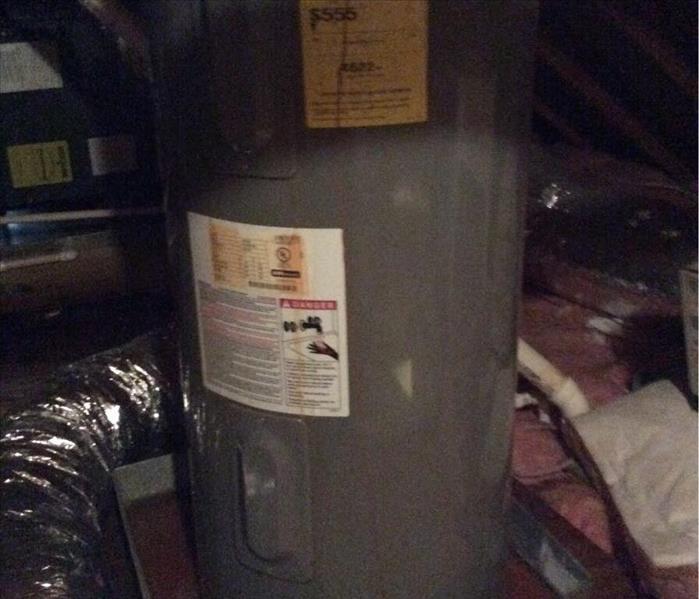Recent Water Damage Posts
3 Common Causes for Commercial Water Losses & How to Prevent Them
8/14/2023 (Permalink)
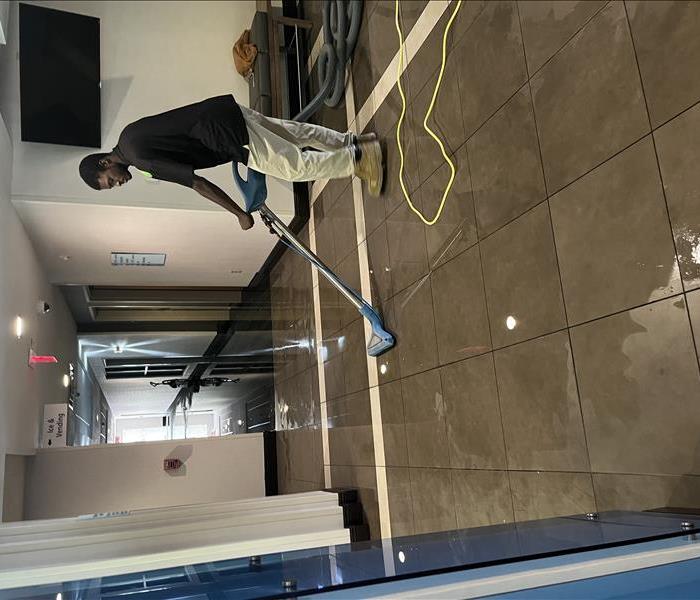 Water cleanup due to a busted pipe at a hotel
Water cleanup due to a busted pipe at a hotel
For business owners or property managers, large commercial structures require a lot of up keep, attention to detail, and organization in order to keep them running in tip top shape. It is crucial to stay up to date on reunion matience, having a mastered emergency plan, and having a strong team to support you. While most disasters are preventable if these steps are taken, some will happen no matter what. One disaster can disrupt your building for hours, days, weeks, and even permanently if you are not careful. There are three common causes for large water losses to look out for.
HVAC failures/Drain pan over flow
Your air conditioner removes moisture from the air and as a result, condensation forms. The condensation travels from the indoor coil to the drain pan and through the drain line. These drian pans can over flow for many different reasons. It is usually from a crack in the pan or excess debris causing a clog. In order to prevent these water damages there are a few small and easy steps to take. Install a float switch. This will shut off your air conditioning if water in the pan gets too high, giving you a clear sign that it needs help. You can also schedule maintenance appointments once or twice a year to insure a professional is keeping everything well maintained.
Plumbing leaks
Busted and leaking pipes is a constant issue for structures with stacked plumbing such as hotels and other hospitality facilities. A crack as small as 1/8 inches can leak up to 250 gallons of water a day! The average commercial water disaster can cost up to $500,00 so it is critical to take steps to keep pluming pipes in good condition. Making sure to replace any leaking fittings or drains, note and investigate any finding of standing water, keeping the pipes warm in a freeze, and add water flow sensors around toilets, bathtubs, washing machines, etc.
Roof leaks
The most common source of commercial water leaks is a roof leak. These commercial buildings usually have HVAC equipment, skylights, and vents that increase the amount of access points water has to enter the building. When preventing roof leaks it is important to never push the limit with the lifetime of your roof. Replace it when the time comes and do not push it off. Smaller preventative steps to take include cleaning out drains, removing debris, and scheduling regular roof inspections.
SERVPRO of Bay St. Louis/Diamondhead has trained and certified technicians to help with any water damage that might come your way. We can also help you plan for those emergency’s with our free Emergency Ready Profile service. Call our office today to schedule your ERP or anytime with any restorations needs! (228)467-4450
Missing This Endorsement on Your Insurance Policy Could Cost You
2/17/2022 (Permalink)
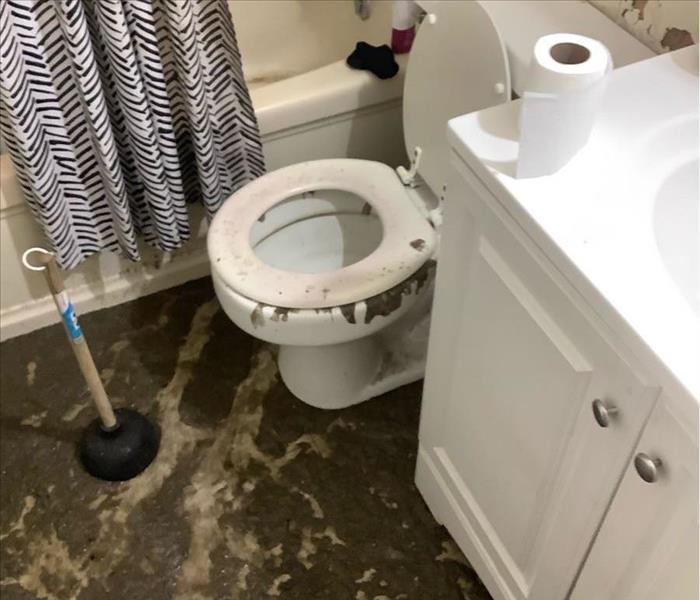 SERVPRO of Greater Covington and Mandeville specializes in biohazard cleanup.
SERVPRO of Greater Covington and Mandeville specializes in biohazard cleanup.
Water backup coverage, also referred to as sewer backup or sump pump failure coverage, is one of the most overlooked coverages in an insurance policy. Most insureds assume it’s a typical coverage buried somewhere within their lengthy declaration page. Unfortunately, it doesn’t exist in the average standard homeowners or renters insurance policy. Water backup coverage is a special endorsement that needs to be added to your policy to ensure coverage.
What causes water to back up into your property?
A drain, sewer, or gutter clog can cause water to back up into your property. Often the clog is caused by debris buildup or heavy rain. Water can also back up into a structure when a sump pump fails.
How much does water backup coverage cost?
A water damage event caused by a sewer system backing up or by a sump pump failure can cost thousands of dollars for mitigation and reconstruction. These types of water losses involve category 3 “black” water and require specialized protocols due to biological contaminants. Thankfully, water backup coverage is inexpensive, often costing as little as $50 per year.
Do you have water backup coverage?
When reviewing your insurance policy, special endorsements are usually found on the last few pages. You should ask your insurance agent to verify that you have water backup coverage. If you don’t have a water backup endorsement, then ask your agent to add it to your policy immediately.
How to prevent a water backup loss
- Regularly inspect drains and gutters. Remove debris
- Do not flush anything besides toilet paper down toilets
- Do not overuse garbage disposals or pour grease down drains
- Have a plumber inspect the plumbing system every year to find and address any issues promptly
What to do if you have a water backup loss
When a water backup loss occurs at your home or business, you must act fast to mitigate damages. First, contact a local plumber to find the problem and stop the sources. Then, call our office to have a mitigation crew dispatched to your property. Our team is available 24/7/364 for emergency services.
5 Water Damage Prevention Tips for Freezing Temperatures
1/19/2022 (Permalink)
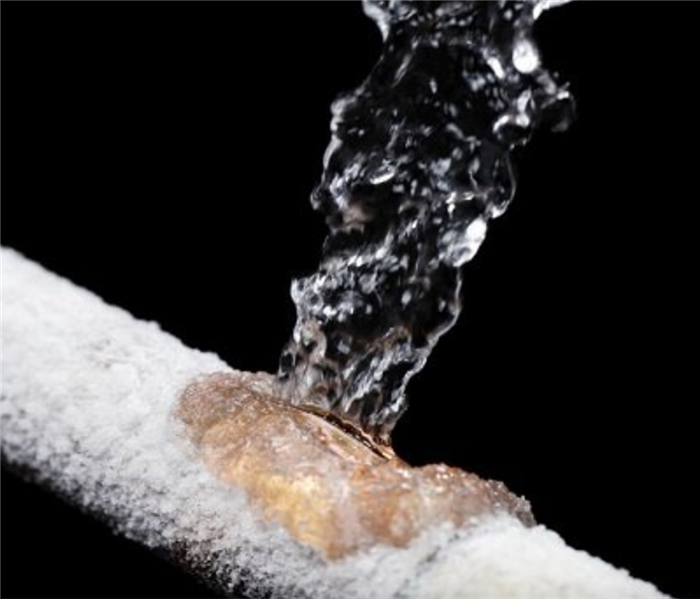 SERVPRO of Greater Covington and Mandeville is here to help 24/7/365. Please contact our office for water damage mitigation assistance. 985-871-5375
SERVPRO of Greater Covington and Mandeville is here to help 24/7/365. Please contact our office for water damage mitigation assistance. 985-871-5375
Freezing temperatures and winter storms increase the risks of property damage claims due to water damage events. Water damages during winter are often the result of frozen pipes bursting. Follow our tips below to protect your property this season.
How to Prevent Frozen Pipes:
- Leave one faucet slowly dripping water
- Open kitchen and bathroom cabinets to promote warm airflow around exposed pipes
- Keep your home thermostat set to at least 65 degrees both day and night, even when unoccupied
- Cover pipes with foam rubber or fiberglass insulations and secure them with tape
- Remove garden hoses from outside faucets and wrap pipes
If your pipes do freeze and burst, first locate your main water shut-off valve immediately to turn off the water supply. Then, contact a plumber to locate and fix the broken pipe. Next, call SERVPRO of Greater Covington and Mandeville for professional water damage mitigation. Our water damage production team will extract all loose water and dry the remaining materials to prevent secondary damages. From Covington, Louisiana to Bay St. Louis, Mississippi, our team is here to help 24/7/365.
3 Common Water Damage Causes and How to Prevent Them in Your Home
12/27/2021 (Permalink)
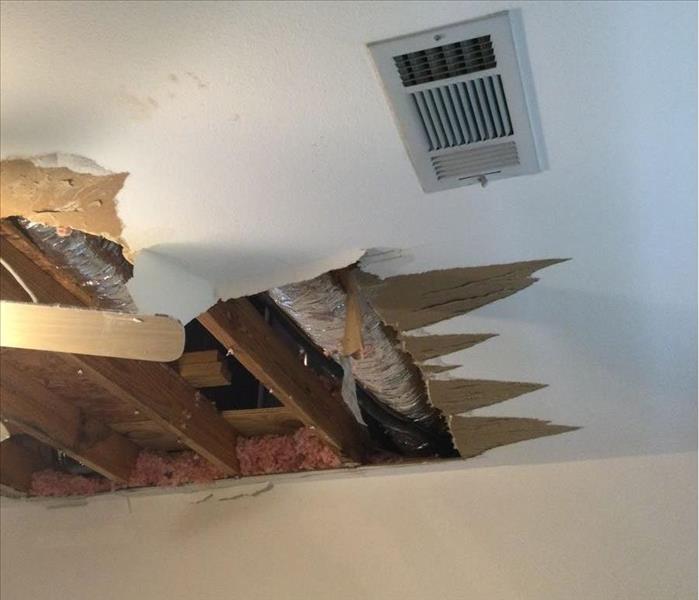 SERVPRO is the #1 choice in fire and water cleanup and restoration.
SERVPRO is the #1 choice in fire and water cleanup and restoration.
Water damage is the second most common reason why homeowners file an insurance claim, preceded only by fire and lightning disasters. According to Insurance Information Institute, about one in every fifty insured homes has a property damage claim caused by water damage or freezing each year. Chances are high that either you or one of your family or friends will one day experience a water damage event at home.
Since 2009, SERVPRO of Greater Covington and Mandeville has provided water mitigation services for thousands of homes and businesses throughout the Northshore and Greater New Orleans region. Our water production team has responded to water damages caused by almost every type of accident you can imagine, from burst water pipes because rats were chewing on them to a fire suppression system being triggered because it was simply too hot one summer day. But our typical water damage emergencies are caused by one of the following three reasons.
3 Most Common Causes for Water Damage Claims
1- Burst Water Pipe
Broken or cracked water supply lines are probably the most frequent culprits of water damage incidents our team encounters. To best prevent these accidents, routinely check exposed pipes under sinks and in attics for leaks and immediately make necessary repairs. Investing in a water leak monitoring and shut-off system will also help to quickly mitigate damages when a leak does occur. And make sure everyone in your home knows where the main water shut-off valve is located in case of an emergency.
2- Water Heater Malfunction or Explosion
Water damages caused by a broken water heater are usually significant losses since most water heaters are stored in attics. When a loss does occur, gallons of water spew from the attic down into living spaces below. Performing regular maintenance on your water heater will help deter a sudden incident. Also, inspect your water heater supply line about once a quarter for leaks. Replace supply lines when warranted.
3- Broken Appliances
The third often recurring cause for water damage claims is broken household appliances such as dishwashers, refrigerators, and washing machines. More specifically, water supply lines to these appliances will sometimes leak or come loose altogether, resulting in water and or mold damages. Inspect the water supply lines to your dishwasher, refrigerator, and washing machine at least a couple of times a year. If your appliance seems to be overflowing or improperly working, then have it inspected and repaired as soon as possible.
When a water damage event does occur at your home, our team is here to help 24/7/365. Our water mitigation team is trained and IICRC certified to clean up water damages, dry your home back to preloss conditions, and prevent secondary damages like mold growth. SERVPRO of Greater Covington and Mandeville services Abita Springs, Covington, Mandeville, Madisonville, Folsom, and Ramsey.
Water Damage Mitigation Basics: Understanding Class of Water
11/1/2021 (Permalink)
When a water damage event occurs at your home or business, our mitigation professionals begin the restoration process by inspecting and assessing the extent of damages. Which materials must be removed and replaced and how long the drying process will take depend upon the category and class of water intrusion. Category of water denotes the level of contaminants in the water. Class of water references the size of the affected area and is used to determine how much drying equipment will need to be utilized.
Class 1 Water Intrusion
Class one signifies the least amount of water absorption. In this case, the affected wet, porous materials only account for less than five percent of the total floor, wall, and ceiling surface area. Also, the affected materials are considered low evaporation materials. The drying process could take three days or less.
Examples of Class 1 water intrusions include:
- When there is little to no wet carpet or carpet pad
- A concrete floor that has absorbed small amounts of water
- Low porosity materials like plywood, framing, and concrete have been affected
Class 2 Water Intrusion
Class two is defined by a significant amount of water absorption and a significant rate of evaporation. A class two water loss is one in which five percent to forty percent of the combined floor, wall, and ceiling surface area is affected. The drying process could take three or four days.
Examples of Class 2 water intrusions include:
- When 5% - 40% of carpet, carpet pad, and drywall are saturated
- When water has wicked up the wall less than 24 inches
- When a bathroom sink overflows but is stopped before affecting other rooms
Class 3 Water Intrusion
Class three is the greatest amount of water absorption by materials. The wet, porous materials total more than forty percent of the combined floor, wall, and ceiling surface area. The drying process could take three to five days.
Examples of Class 3 water intrusions include:
- When entire carpeted rooms have been affected
- When water has wicked up drywall more than 24 inches high
Class 4 Water Intrusion
Class four refers to deeply bound or held water that causes significant damages. Materials present in a class 4 loss have very low porosity or multiple layers. The drying process could take five days or longer.
Examples of Class 4 water intrusions include:
- Saturated plaster walls
- Drenched hardwood flooring with another layer of flooring underneath, on top of the subfloor
- Deeply saturated stone or brick
At SERVPRO of Greater Covington and Mandeville, our water damage restoration technicians receive certifications for applied structural drying from IICRC, a non-profit restoration industry organization. Our certified, experienced crew is available 24/7/365 for all water damage emergencies. For assistance, please dial 985-871-5375.
3 Tips to Prevent Your Water Heater From Leaking or Exploding
8/19/2021 (Permalink)
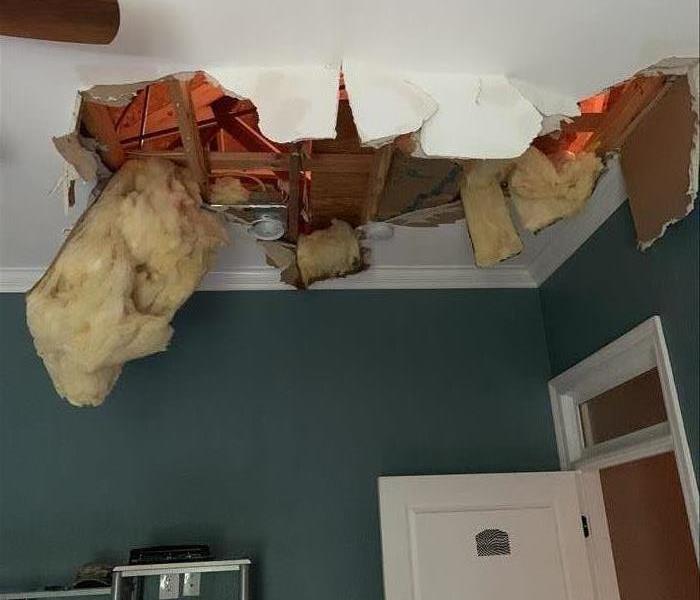 Performing regular maintenance on your water heater will help prevent water damages in your home.
Performing regular maintenance on your water heater will help prevent water damages in your home.
Can you imagine 40 or 50 gallons of water gushing out of your water heater? Water heater leaks and explosions are two of the most common culprits responsible for water damages in homes. And where are water heaters usually located? That’s right. In the South, especially in Louisiana, water heaters are stored in attics. Storing your water heater out of sight in an attic is convenient. However, this positioning in your home often leads to a major disaster when the water heater leaks or explodes.
So, how do you avoid your water heater causing water damage in your home? Regular maintenance on your water heater can help extend its lifespan and avoid malfunctioning. Follow the three tips below to keep your water heater working properly. Be careful while attempting any maintenance on your water heater though. Contact a local plumber for assistance if you are unsure how to perform these tips or if you need help.
Tip 1 - Test the Temperature & Pressure-Relief Valve
The temperature and pressure relief valve (TPV) works to prevent an explosion by releasing pressure. If your valve is leaking or releases too often, you may have a problem. The best practice is to test your TPV twice a year. To do so, place a bucket below the discharge pipe on your water heater and gently lift the lever. Replace the valve if water does not release when you lift the lever. If water leaks after the test, move the lever up and down a few times to shake away debris that may be an issue. If the leaking continues, try lowering the temperature and/or pressure.
Tip 2 - Inspect the Anode Rod
If your water begins to smell or seems discolored, it may be time to change the anode rod. The anode rod is designed to corrode instead of deteriorating the lining inside the water heater. Because of this breakdown, anode rods should be replaced every few years.
Tip 3 - Drain the Tank and Rinse Out Sediment
If you hear gurgling, knocking, or popping sounds coming from your water heater, then you may have a buildup of sediment. Sediment buildup can lead to a malfunction and reduce efficiency. About once every few months, drain the tank to avoid sediment buildup. Consult your owner’s manual for instructions on how to properly drain your water heater’s tank. Be careful because the water will be extremely hot.
Our water damage restoration team is here to help 24/7/365 if your water heater does leak or explode. When this happens, you must first turn off the water supply valve to stop the flow of water. Locate the cold-water supply valve and turn it off. Contact a local plumber if you are unable to do so. Then, call our office to have an emergency response team dispatched for water extraction and drying.
Your Water-Resistant Vinyl Floors are not Waterproof in the Event of a Water Loss
8/10/2021 (Permalink)
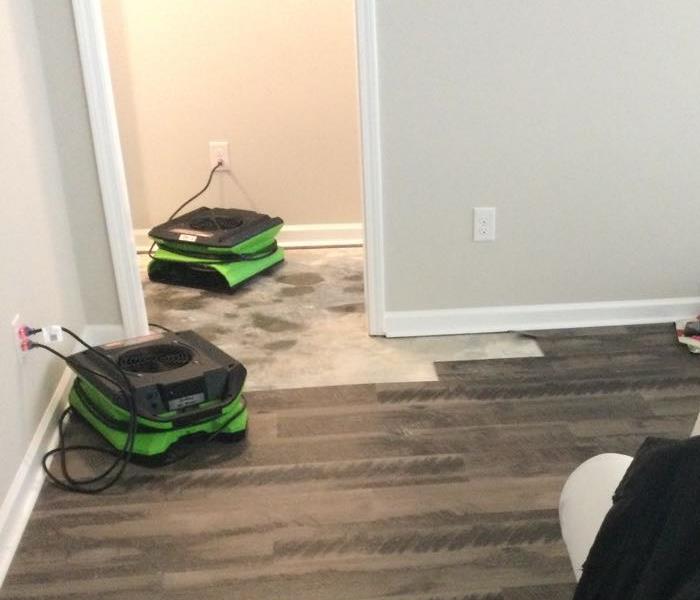 Affected vinyl plank flooring must be removed after a water damage event to ensure proper drying.
Affected vinyl plank flooring must be removed after a water damage event to ensure proper drying.
Vinyl plank flooring has become a popular choice for renovations and new construction. Both homeowners and business owners are opting for this low-cost flooring material for a few reasons. Vinyl plank flooring is easy to install, looks fresh and modern, and is easy to clean. Vinyl plank flooring is also advertised to be water-resistant. While vinyl plank flooring does resist water damages like warping, cracking, or peeling, this type of flooring presents other challenges when a water damage event occurs.
Common water damage events are caused by sources such as a broken water heater, an overflowing washing machine, or a burst water supply pipe. Despite the cause or size of the disaster, the water damage mitigation process is always the same. Our professional water mitigation team inspects and assesses damages, extracts the loose water, utilizes air movers and dehumidifiers to dry affected materials, and cleans remaining materials. Vinyl plank flooring interrupts this process, adding more required demolition to the scope of work.
Our team must inspect all potentially affected areas during the initial inspection to determine where the water has traveled and where it may be hiding. If not addressed, the water you can’t see can lead to future secondary damages such as mold growth. Water may not penetrate through the vinyl plank flooring, but it will almost always migrate under the flooring by way of the edges of the room. Water trapped behind baseboards will flow under the flooring.
Vinyl plank flooring acts as a vapor barrier, trapping the water beneath. This presents two issues. One, our mitigation team cannot extract water hiding underneath the flooring. The hidden water will not vaporize through the flooring to be extracted via dehumidification either. And two, the subfloor will not be able to dry properly with this vapor barrier holding moisture. Both issues can lead to future microbial growth problems. Therefore, all affected vinyl plank flooring must be removed after a water damage event to ensure proper drying. Luckily, some vinyl plank flooring is easy to reinstall once mitigation is complete. This depends upon the initial installation method though.
Our team is here to help if your home or business has incurred water damages. We have emergency restoration professionals ready to respond 24/7/365. Please contact our office if you need assistance.
St. Tammany Parish Awarded Ten Million Dollars in Flood Risk Reduction Projects
3/29/2021 (Permalink)
Flooding due to heavy rain or hurricanes has become a more frequent problem for residents and business owners throughout St. Tammany Parish. In the past few years, pockets within the cities of Covington, Mandeville, Madisonville, Bedico, and Abita Springs have experienced unforeseen flooding. These areas were not particularly at risk ten or even five years ago.
On Friday, March 26th, St. Tammany Parish Government announced the Louisiana Watershed Initiative has awarded St. Tammany Parish ten million dollars in Community Development Block Grant Mitigation for nonstructural projects. The state’s Community Development Block Grant Mitigation Action Plan will focus on natural flood management, flood control, and critical infrastructure projects.
This news brings hope to many after the unusual flooding incidents that are becoming all too common.
To learn more about your property's risk factor visit https://floodfactor.com/.
Common Water Damages Caused by Commercial Fire Suppression Systems
3/3/2021 (Permalink)
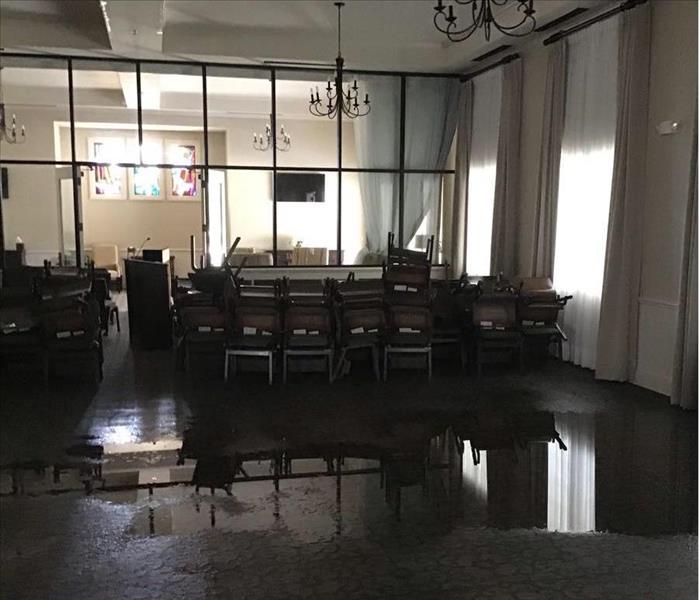 Fire Suppression System Malfunction Caused This Water Damage at a Covington Commercial Property
Fire Suppression System Malfunction Caused This Water Damage at a Covington Commercial Property
Most commercial and multi-family housing properties have a “wet pipe” fire suppression system. This type of system activates when a fire occurs or when extreme temperatures over 155 degrees heat sprinkler heads. Water is then released to quickly suppress the source. Each sprinkler head is individually activated on a needs basis to minimize water damages. However, just one sprinkler can release 8-24 gallons of water per minute. Our restoration team often encounters the following three water damage events caused by fire suppression systems.
Water Damages Caused by Fire Suppression
Often, the fire itself causes less damage than the water used to extinguish the fire. Residential fires are most often doused only by firefighter hoses. Fires at commercial properties are usually extinguished by both the fire suppression system and water utilized by firefighters. This can result in thousands of gallons of water inside the commercial building.
Water Damages Caused by Fire Sprinkler Malfunction
While this is a less common incident, our team has helped several commercial clients after their fire suppression systems accidentally initiated. For one example, a commercial property in Covington was newly built, but the fire suppression system was not calibrated for the correct heat resistance. On a particularly scorching hot summer day, the fire sprinkler system was accidentally activated and leaked thousands of gallons of water into over 4,400 square feet of the building.
Water Damages Caused by Frozen Fire Suppression System
Many commercial buildings in South Louisiana are not constructed to endure below freezing temperatures. Every couple of years, an awful winter storm will bring extremely low temperatures to our area. These dramatically low temperatures will cause water supply pipes and fire suppression systems to freeze. Sometimes the pipes will safely defrost in a day or two, but other times they will expand so much that they burst.
The above disasters can be mitigated by properly maintaining commercial fire suppression systems and knowing how to turn off the system when an incident does occur.
No matter the reason why a fire suppression system has caused water damages, our emergency restoration team is here to help 24/7/365. With our professional extraction equipment, our water damage restoration team will quickly extract all loose water. Then, we will utilize our drying and dehumidification equipment to return the property back to preloss condition. In a matter of days, our water damage restoration team can make any size disaster seem “Like it never even happened.”
Home Safety Tips for the Holiday Season
12/3/2020 (Permalink)
Thankfully, we are now officially finished with hurricane season. However, this time of year is almost just as busy for the insurance claims industry. While holiday decorations brighten our spirits, they are often the culprit of many home fires. Frozen temperatures lead to bursting water pipes. And not preparing your home before leaving for a holiday vacation sometimes makes for an unpleasant return.
SERVPRO of Greater Covington and Mandeville is here to help you before, during, and after a disaster occurs. Follow the home safety tips below to best prevent accidents and to be prepared in case one does happen.
- Use flameless or fire-retardant decorations
- Blow out candles when exiting a room
- Never leave food cooking on the stove unattended
- Check Christmas lights for frays or hazards
- Water your Christmas tree frequently
- Test the batteries in your smoke alarm each month and change the batteries if necessary
- Clean leaves and debris from gutters and drain sprouts to ensure proper drainage
- Only plug space heaters into wall outlets. DO NOT plug space heaters into surge protectors
- Turn your home's main water supply off and drain the lines when planning to vacation for more than a couple of days.
- Clean the lint from your dryer hose
- Practice your home fire escape plan with your family
If a water or fire event does occur at your home, our emergency restoration team can be reached 24/7/365 by dialing 985-871-5375. For water damage mishaps, please locate the source of the loss first and shut it off. You may need to contact a local plumber for assistance. For responding to a home fire, please do not reenter your home until it is safe to do so. Our fire restoration team can help walk you through the claims process and make any size disaster seem "Like it never even happened."
For more home safety tips or to learn how to prepare your business for an emergency, send an email to Kayla@SERVPROofCovington.com.
Water Damage Restoration: Moisture Detection and Drying Equipment
8/31/2020 (Permalink)
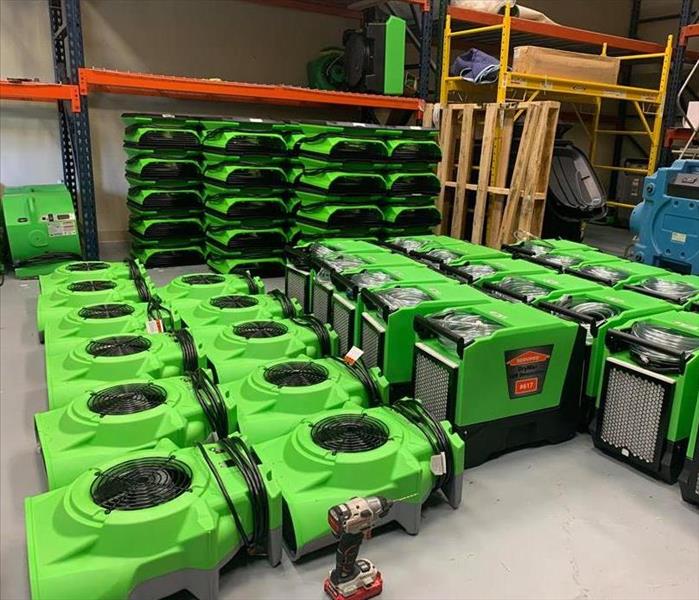 SERVPRO of Greater Covington and Mandeville has a wide variety of moisture measuring tools, air movers, and dehumidification equipment.
SERVPRO of Greater Covington and Mandeville has a wide variety of moisture measuring tools, air movers, and dehumidification equipment.
Professional water damage restoration includes proper damage assessment, water extraction, and drying techniques. Our water damage restoration technicians receive certifications from the Institute of Inspection Cleaning and Restoration Certification, a non-profit organization focused on setting standards for the inspection, cleaning, and restoration industries. Certified, trained, and equipped with the following state-of-the-art restoration tools, our water damage restoration team makes any size disaster seem “Like it never even happened.”
Step 1: Damage Assessment- Utilize Moisture Detection Equipment
The initial steps in the water damage restoration process are to assess the damages and locate where water has traveled. Our water damage restoration technicians seek to understand which materials were affected and how saturated they are. During the investigation, the restoration professional notes all materials, building components, and contents affected by the water as well as saturation levels.
- Moisture meters- Used to measure the amount of water content in materials such as drywall, flooring, or baseboards. Moisture meters come in two main types: penetrating and non –penetrating.
- Penetrating meters have surface-piercing prongs that work on the principle of electrical conductivity, which identifies trapped moisture on various surfaces. Penetrating meters like moisture probes determine the saturation on a percentage scale. By comparing non-affected materials to affected materials, our team determines the drying standards for specific materials.
- Non-Penetrating meters are equipped with two sensors and use conductivity or radio frequencies to detect moisture. Thermal infrared cameras are non-penetrating tools our team uses to determine which materials are saturated. These cameras capture images in hard to reach locations and save images in a microSD card. Thermal imaging cameras are perfect for detecting water inside wall cavities and under cabinets.
- Hygrometers- Used to measure both temperature and humidity concentration within the water-loss areas. Hygrometers help determine humidity levels which allow restoration professionals to determine how to stabilize the environment for adequate drying.
Once the extent of damages is determined and water class and category have been identified, our water damage restoration professionals will construct the water extraction plan.
Step 2: Water Extraction- Utilize Professional Extraction Equipment
SERVPRO of Greater Covington and Mandeville has a variety of water extraction equipment. Variables such as type of flooring, water depth, and power availability will determine which pumps and extraction tools should be used. Our goal is to extract as much water as possible as quickly as possible to prevent secondary damages.
- Extraction units- Are portable or truck mounted. Portable units can be taken almost anywhere but require an electric power supply. Portable units can hold about a dozen gallons of water before needing to be dumped. For larger jobs or those without a power source, our restoration professionals will opt to use our truck-mounted extraction equipment. The truck’s tank can hold seventy-five gallons of water.
- Carpet wands- Carpet wands attach to all extraction units.
- Pumps- Remove standing water that is more than 2 inches deep. Submersible pumps can be used to quickly remove standing water in hard to access areas like basements, crawl spaces, and construction sites.
After all loose water has been extracted, the drying process will commence.
Step 3: The Drying Process- Utilize Drying and Dehumidification Equipment
Water restoration professionals strategically place drying equipment throughout affected rooms. We adhere to IICRC drying standards and Xactimate, a restoration software used by all insurance industry professionals, to determine how many pieces of each equipment are necessary and how best to arrange them.
- Air movers- Air movers are positioned to create a vortex of airflow to promote faster drying. Increasing the rate of evaporation, rapid air movement reduces the chances of secondary damages like mold growth. The two main types of air movers are centrifugal air movers and axial air movers.
- Dehumidifiers- Used to remove water vapor from the air. Dehumidifiers intake moist air, remove water, and exhausts warm, dry air. Two types of dehumidifiers are low grain refrigerants (LGRs) and desiccants.
- LGRs work on the premise of condensation and work best in temperatures between 70 degrees and 90 degrees Fahrenheit. Moist air moves across cold evaporator coils and is cooled below its dew point, condensing water on the cold coils and fins. Water is drained off the fins into a collection tank and pumped out into a sink or water barrel.
- Desiccant dehumidifiers work on the premise of condensation and are most efficiently remove moisture in temperatures below 70 degrees. Desiccants use a silica gel to absorb moisture.
Each day during the drying process, our restoration technicians will return to monitor material moisture content, check the temperature, and calculate the humidity ratio. All equipment will be inspected and rearranged if necessary. Equipment will be removed as specific materials and areas are deemed dry. The drying process is typically complete within three days.
If your home or business has been affected by a water damage event, then please contact our office by dialing 985-871-5375. Our emergency water restoration team is available 24/7/365 to serve our friends and neighbors in Covington, Mandeville, Abita Springs, Madisonville, and Folsom.
Filing a Damage Claim With a Retail Store? The Process May be More Difficult Than You Think.
8/17/2020 (Permalink)
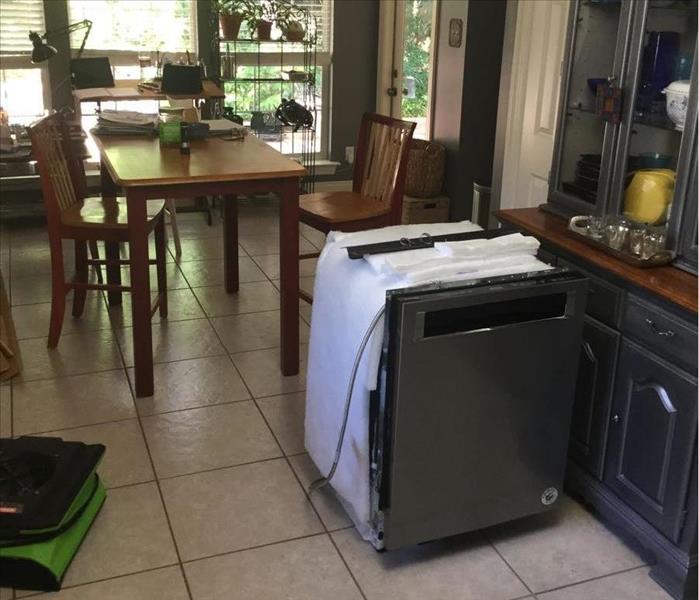 Faulty installation of dishwasher leads to water damages in Covington home
Faulty installation of dishwasher leads to water damages in Covington home
You will probably experience a water damage event at your home at least once in your lifetime. According to the Insurance Information Institute, “about one in 50 insured homes has a property damage claim caused by water damage or freezing each year”. The most common causes of water damage include broken pipes and malfunctioning appliances. Oftentimes, a water supply line to a refrigerator, dishwasher, or washing machine will disconnect and leak water throughout the home.
In the past month, our water damage restoration team has helped two homeowners who suffered a water damage loss due to the faulty installation of a dishwasher. Both homeowners had purchased their dishwashers from national retail stores and paid for installation. Typically, large box retail stores will subcontract the installation process to a local company. In each account, the dishwashers’ water supply lines were not connected correctly and caused water damages in each homeowners’ kitchen and dining room. The damages were not significant for either homeowner, but the claims process proved to be the most stressful.
So, what do you do when a subcontractor’s negligence leads to damages in your home? You can file a claim with the retail store’s claims department. The claims department will review the claim and determine if compensation will be rewarded. Keep in mind, regardless of if the claim is approved or not, you have the responsibility as a homeowner to begin mitigation as soon as possible. Homeowner’s insurance policies clearly state this, and future damages could be denied if you do not attempt to mitigate damages in a timely manner. Despite whom takes responsibility for the incident, the damages still need to be taken care of. Therefore, your first step should be to call our team to initiate mitigation promptly. Then, begin the claims process with the retail store.
National retail stores use third-party claims management companies like Sedgwick to manage their claims. And the subcontractors that install appliances often use third-party claims management companies as well. At the end of the day, you could end up with multiple claim numbers, adjusters, and little concrete information about your claim. Remember to take notes of each phone call with a claim representative or adjuster. Record the date, person’s name, and information discussed.
After the restoration process is complete, you will be required to send all documents, pictures, and mitigation invoices to the claims department for review. Our water damage restoration team documents every step of the restoration process for our customers. By choosing SERVPRO of Greater Covington and Mandeville, you will have everything you need to prove losses to the retail store and third-party subcontractor. However, in our experience, each retail stores’ claims process is slow and troublesome. You may wait months for any resolution. We will help as best we can to walk with you through this process, reaching out to claims departments and following up with adjusters often.
Please call our office if you have any questions regarding our water restoration process or need assistance filing a claim. Our office phone number is 985-871-5375.
Improper Water Cleanup Can Lead to Future Mold Damage
7/27/2020 (Permalink)
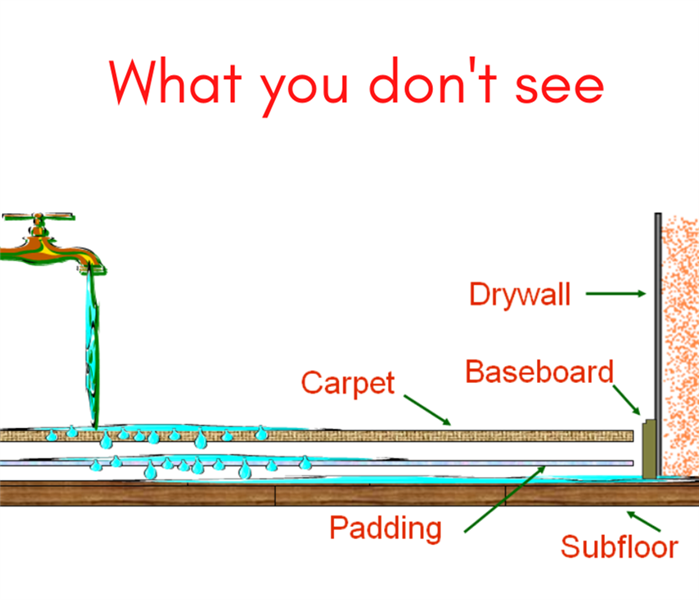 The water you can't see could lead to future damages.
The water you can't see could lead to future damages.
When a water damage event occurs at your home, your biggest concern should be the water you cannot see. Soaking up water with towels or using a shop vacuum to extract water will not remove the water hiding underneath flooring and behind baseboards. Water will always find its level. During a water damage event, water will flow into spaces you cannot detect by just glancing around.
Upon initial inspection of your home, one of our water damage restoration project managers will utilize a moisture probe to determine which materials are wet and how wet they are. They will check all flooring near the damaged area, along with the baseboards and drywall. If a carpeted room is reading wet, then the carpet pad will be removed because it cannot be dried. Usually, the baseboards in an affected room will also need to be removed to determine if water flowed behind them and is present. Once our team has determined which materials are still wet and the full extent of water damages, we will strategically place equipment to stabilize the environment and dry the affected materials. The typical drying process is complete within three days.
You can trust our professionals to find the water you cannot see when a water damage event, like one caused by a leaking water supply pipe or a water heater explosion, occurs in your home. Our water damage restoration technicians are IICRC trained to thoroughly discover the full extent of damages and properly dry the affected spaces to prevent future mold damages. We are also available 24/7/365 for emergency restoration services. Our office number is 985-871-5375.
Water Damage Mitigation Basics: Understanding Categories of Water
7/8/2020 (Permalink)
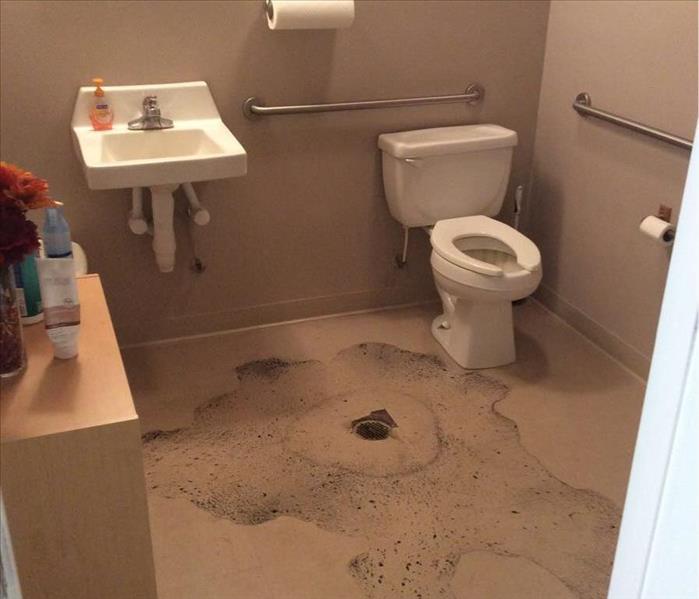 Water from a sewage system backup is considered Category 3 water.
Water from a sewage system backup is considered Category 3 water.
Each water damage event is unique. The extent of mitigation required by restoration professionals depends on several variables such as where the water came from and which type of materials have been affected. Two of the most important factors mitigation and restoration professionals must consider are the category and class of the water. Category of water refers to how contaminated the water is. Class refers to how much of the area has been affected.
Water Damage Categories
Based upon the IICRC S500 Standard and Reference Guide for professional water damage restoration, categories of water depend on the following:
- Where the water came from (source)
- How long the water has been in the structure
- The temperature within the structure
- Preexisting conditions of the structure (how dirty are the affected areas)
Category 1 Water
Category one water is considered clean water. This type of water originates from a sanitary source. It does not pose a substantial risk from exposure. Water damage events with category one water often require minimal removal of wet materials unless the materials are structurally or aesthetically damaged.
Examples of category one water are:
- water from a broken water supply line
- bathtub or sink overflow with no contaminants
- appliance malfunctions like a leaking ice line on a refrigerator
- broken toilet bowl tanks
- water from a clean source that is quickly discovered and extracted
Category 2 Water
Category two water is considered slightly contaminated due to a significant degree of chemical, biological, or physical contamination. It has the potential to cause discomfort or sickness if contacted or consumed by humans. Water damage events involving Category 2 water often require materials like carpet pads to be removed and discarded.
Examples of category two water include:
- water discharged from dishwashers or washing machines
- water from fish tanks
- overflow from the toilet bowl
- water that has sat for more than a day
Category 3 Water
Category three water is considered grossly contaminated. This type of water can contain pathogenic, toxigenic, or other extremely harmful agents. It can cause significant adverse reactions in humans if consumed or contacted. Porous materials affected by category three water should be removed and replaced. Also, an antimicrobial agent must be applied to the remaining structure and materials to prevent secondary damages.
Examples of category three water include:
- water caused by sewage system backups
- water from storm damages
- water from rising rivers or streams
- water that was present in structure for days
SERVPRO of Greater Covington and Mandeville's water production team is here to help 24/7/365 when a water damage event occurs at your home or business. If you need assistance, please contact our office by dialing 985-871-5375.
How to Prevent Common Water Damage Disasters in Your Home
2/17/2020 (Permalink)
According to the Insurance Information Institute, about one in every fifty insured homes has a claim related to water damage or freezing temperatures each year. It may surprise you that most of these water damage claims are not related to natural disasters, but are caused by ordinary accidents. Some common causes of water damage events in homes include old, cracked water pipes, broken frozen pipes, sewage system failure, and water leaks attributed to malfunctioning appliances. It’s shocking how common it is for either a washing machine to overflow or for a water heater to explode. Both of said events can cause significant water damage in a home.
In order to escape having an incident at your home, you should keep up with regular home maintenance repairs and do a complete walkthrough once a month to inspect appliances for any problems. Check under kitchen and bathroom sinks to make sure no water is slowly dripping from a cracked or ill-fitted pipe. Pull out your refrigerator once a month to see if the water line is properly connected and if there are any mold surprises growing behind it. This is a relatively common issue that most homeowners don’t discover until it’s an obvious, big mess.
Another helpful tip for catching water damage problems before they are huge disasters is placing water detectors underneath sinks, in the water heater drip pan, and in other areas prone to water damage. When water is detected the alarm sounds to alert you to locate the issue and fix it promptly.
If a water damage event has occurred in your home, then our water damage restoration technicians can help extract the water and properly dry any wet materials. Our highly experienced and knowledgeable team is available 24/7 every day of the year. For assistance please contact our office by dialing 985-871-5375.
Frequently Asked Questions Regarding Water Damage
10/2/2019 (Permalink)
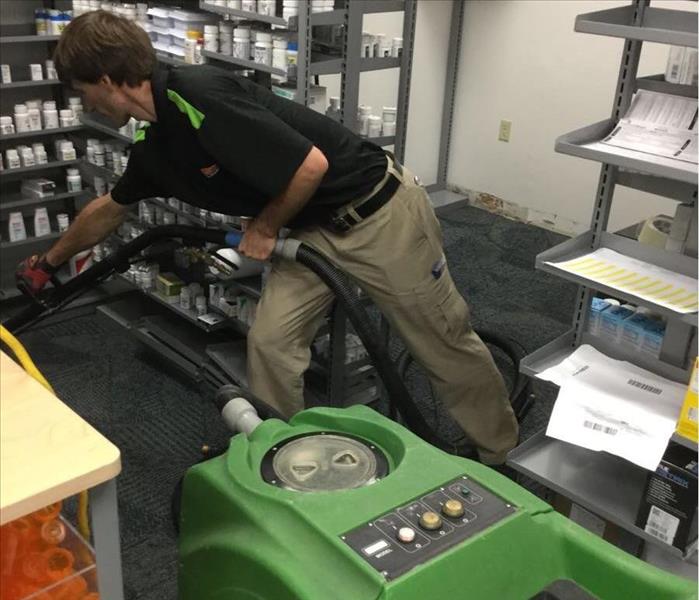 Water Damage Restoration Technician Extracts Water from Covington Business
Water Damage Restoration Technician Extracts Water from Covington Business
Water damage claims are one of the most frequent types of insurance claims in the United States, only second to wind and hail damage claims. Water damage claims are commonly caused by sudden or accidental damages, sewer system backups, overflow, and flooding events. Sudden damages are usually attributed to either a water pipe breaking, a water heater exploding, a water supply line to an appliance disconnecting, or other similar accidents. Please note that flooding events are not covered by homeowner’s insurance policies and claims must be made through flood insurance carriers. Water damages caused by sudden damages will more than likely be paid for buy your insurance company. However, gradual damages caused by slowly accrued water problems may not be covered by your homeowner’s policy. For instance, if you neglected repairing a hole in your roof and water is slowly leaking inside your home causing damages, then your insurance company may deny your claim. To learn more about your specific insurance coverage please speak with your local insurance agent.
Below are a few frequently asked questions homeowners have for our water damage restoration technicians. Please send an email to kayla@SERVPROofcovington.com if you would like additional information regarding water damage claims.
Who is responsible for making repairs to the cause of the water damage?
Under most circumstances, the homeowner or policyholder is responsible for repairing the cause of the water damage. Most insurance policies only cover damages, not repairs to broken appliances or parts of the home's structure. For example, in the case of a water heater exploding thus causing a water damage event, the homeowner or policyholder would be responsible for repairing or replacing the water heater.
How much will this cost?
Each water damage claim varies in cost depending on the extent of damages and type of materials affected. The average water damage claims cost $2,500. Our job as your restoration heroes is to restore rather than replace as much as possible. To the best of our ability and in the most efficiently, timely manner, we will work to prevent further damage and salvage as much as we can. However, sometimes materials can not be restored and we will need to remove them. Once we have completed work, we will send an invoice with documentation to your insurance company.
Can you salvage wood flooring or carpet following a water damage event?
As previously stated, our goal is to salvage as much as possible instead of removing materials. We want to save you both time and money. However, in some instances we may need to remove wood flooring or carpet. We act to return your property back to “preloss” condition. For instance, if due to the water damage your furniture has left stain marks on the carpet, then we will speak with your insurance company or adjuster about removing the carpet. Wood flooring may or may not be able to be restored depending on how badly affected the flooring was. When a large amount of wood flooring begins to pop out of place it usually must be removed. Our team will attempt to dry wood flooring that seems to be salvageable utilizing our state-of-the-art Injectidry rescue mat equipment. If the property has been affected by grossly contaminated water from a sewage system or toilet overflow, we will follow IICRC standard cleaning protocol and remove items considered unsafe.
How long will it take to dry everything?
After our water damage restoration technicians have extracted all loose water, they will strategically place fans and dehumidifiers throughout affected rooms. The drying process is typically completed within three days. The drying equipment will be noisy, but turning off the equipment will only prolong the process.
Who can help if I need any rebuild or construction services?
We recommend our partner company Complete Restoration Services for all rebuild and construction services. The Complete Restoration Services team specializes in insurance claims projects and understands how to help you navigate your claim. Complete Restoration Services is also locally owned and operated, and works with all major insurance companies. To inquire about rebuild services please call their office by dialing 985-377-1877.
National Preparedness Month 2019
8/27/2019 (Permalink)
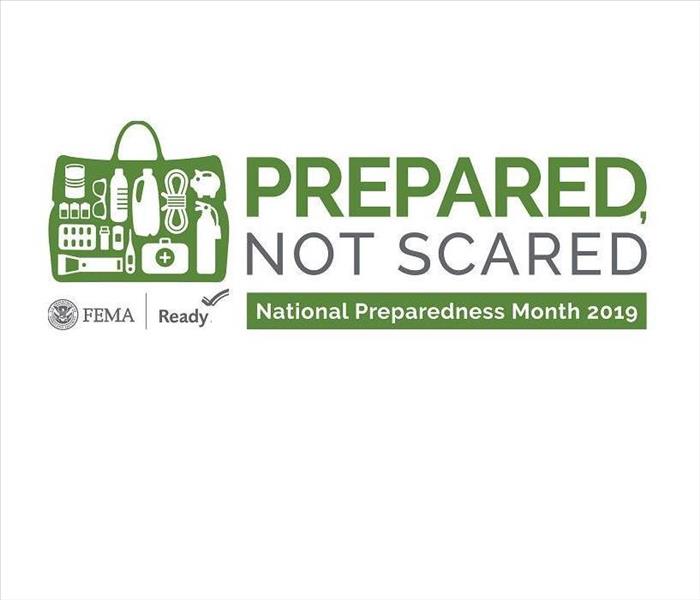 2019 National Preparedness Month
2019 National Preparedness Month
National Preparedness Month, recognized each September, provides an opportunity to remind us all to prepare ourselves, our families, and our businesses for each kind of disastrous situation we may have to endure. The overarching theme for this year is “Prepared, Not Scared" and each week we are encouraged to focus on specific emergency preparedness tasks.
Week 1: September 1st - 7th
Save early for disaster costs.
- Review your insurance documents to make sure you’re properly protected following a disaster. If you do not have flood insurance, then make an appointment with your insurance agent to discuss your options. Remember, many who believed their home would never experience flooding were surprised in 2016 when massive amounts of rain caused heavy flooding in Baton Rouge, Covington, and other cities throughout Louisiana.
- According to the Federal Reserve, 40% of Americans do not have $400 in savings. Are you financially prepared in case of an emergency? Visit https://www.ready.gov/financial-preparedness to learn helpful disaster financial planning tips. It is also a good practice to keep some cash on hand during an emergency in case ATMs or your local bank are affected by the storm.
Week 2: September 8th – 14th
Make a plan to prepare for disasters.
Write down your emergency plans. Create one emergency plan for your family that is inclusive of their specific needs. Families with special needs may require additional planning. Discuss and practice the plan with your family members.
Your family emergency plan should answer the following four questions:
- How will I receive my emergency alerts and warnings?
- What is my shelter plan?
- What is my evacuation route?
- What is family/household communication plan?
Also, part of your home plan should include making an emergency supplies kit. Be prepared for a power outage by having at least three days’ worth of food and water for each person.
Create an additional plan for your office and practice it with your employees. As a business owner or an office manager, your plan should include contact information for each employee and identify whether the employee plans on evacuating during a storm.
Week 3: September 15th – 21st
Teach youth to prepare for disasters.
Discuss ways your children can be prepared for an emergency while at home and when away from home. If your child has a cell phone, then make sure they are signed up for local emergency alerts. Visit https://www.ready.gov/youth-preparedness for more information regarding youth preparedness.
Week 4: September 22nd – 30th
Get involved in your community’s preparedness.
Every community and major city have volunteer organizations focused on disaster response and emergency planning. To locate an organization in your community visit the websites:
https://www.redcross.org/volunteer/become-a-volunteer.html
http://gohsep.la.gov/PREPARE/CITIZEN-CORPS
https://www.nvoad.org/
3 Home Maintenance Tips to Help Prevent Water Damage
8/16/2019 (Permalink)
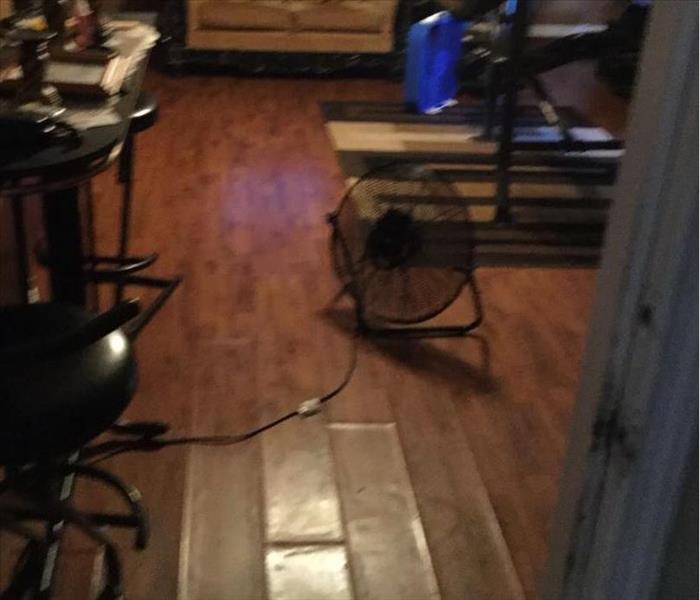 Wood flooring buckling following a water damage event.
Wood flooring buckling following a water damage event.
While sometimes water damages are caused by an accident, like a water supply line break or a water heater malfunctioning, some water damage is due to improper home maintenance. Follow these tips below to help protect your home from incurring water damages:
- Make sure gutters are cleared of debris and properly working to divert water away from your home. When gutters are clogged rainwater can accumulate around the foundation of your home and cause water damage. You should clean your gutters at least twice a year. The best times to do this are right before hurricane season begins in June and one day in November as fall is ending. Downspouts should be positioned 5”-10” from house.
- Hire a roofing professional to examine the condition of your roof once a year and after each major storm. You may be able to notice some major damages yourself without the help of a professional. However, a roofing specialist will be able to detect issues only a trained eye will notice, like shingles that should be replaced or faulty flashing around your chimney. Immediately repair any damages you may find. Often a roof leak may go unnoticed for a significant amount of time and lead to mold or mildew growth inside of the home.
- Check for water leaks underneath sinks, around window casings, and behind your refrigerator. Again, slow, persistent leaks can lead to mold and mildew issues. Water damages also attract termites and carpenter ants. If you notice any leaks, then find the source and correct the issue immediately. After, dry the wet materials or remove all materials that are damaged beyond repair. Our water damage restoration team is available 24/7 for any water damage emergencies.
Important Information Regarding Tropical Storm Barry
7/12/2019 (Permalink)
Over the past few days, our team has been meeting with other SERVPRO® disaster recovery team members to complete our response plan for Tropical Storm Barry. We understand the stress and worry both homeowners and business owners are currently feeling, but please rest assured SERVPRO® of Greater Covington and Mandeville is prepared to handle any size disaster. With our local resources and the help of our national resources, we are prepared and ready to help. Our emergency restoration team will be available 24/7 this weekend to help once it is safe to do so.
We offer the following emergency restoration services:
- Board-up
- Roof tarping and repair
- Flood damage restoration
- Contents restoration
- Document restoration
- Mold remediation
- Project management
- Rebuild
As of now, we urge you to check off the following items from your personal emergency preparedness checklist as soon as possible:
- Fill up vehicles with gas
- Withdraw cash to keep on hand
- Charge your phones and recharge portable phone chargers
- Stock up on enough food and water for at least 3 days
- Stock up on toiletries (don't forget toilet paper or wet wipes) and refill your first aid kits if necessary
- If a storm drain is located outside of your home, then please try to clean it or reach out to someone for help.
- Pick up sandbags and stage outside any areas where water may enter your home
- Continue watching the news and social media for updates
- Be home as early as possible (New Orleans residents are required to be home by 8:00 pm tonight)
For tomorrow:
- Due to the recent algae bloom in Lake Pontchartrain, everyone should avoid coming into contact with any flood waters around the lakefront in Mandeville.
- Stay off the roads as much as possible. If you have to question whether you should drive down the street or not, then don't! Turn around and find another way.
- If your home or business does experience flooding:
- Make sure the property is safe before entering
- Take pictures of everything
- Do not throw anything away before taking pictures and itemizing the items
- Contact us immediately to begin cleanup and reduce secondary damages
- Begin the claims process by contacting your insurance company and/or agent
- If any important documents have been damaged by flood waters and you still have power, then place the documents in a freezer. We can help with document restoration.
Important Resources:
Responding to a Water Damage Event
6/24/2019 (Permalink)
We see it every day, a pipe under the kitchen sink breaks or a water heater explodes and causes a water damage event in your home or business. Chances are that at least once in your lifetime you will deal with a water damage event at home or the office. So, what can you do to prevent unnecessary damages following one of these emergencies? Firstly, as an insured, you have the responsibility to immediately mitigate damages as best as you can. In the examples of a pipe breaking or a water heater exploding, your responsibility would then be to find the source of the water leak, turn the source off by shutting off the water supply line and to begin mitigation as soon as possible. SERVPRO of Greater Covington and Mandeville's water damage restoration technicians are available 24/7 every single day of the year to respond to water damage emergencies. After reaching out to our team for help, you can rest assured our team will help make your water damage event seem "Like it never even happened". By utilizing the science of drying techniques and our state-of-the-art drying equipment, most water restoration projects are complete with the drying process within three days. Next, while our technicians are in route to your home or office you can begin to move any furniture or belongings away from flowing or standing water, take pictures of anything damaged, and start documenting any items that may be ruined beyond repair. All of this information will be helpful should you choose to file an insurance claim.
For more questions regarding water damage claims or water damage restoration, you can send an email to kayla@SERVPROofcovington.com.
Minimize Water Damage With This Product
1/10/2019 (Permalink)
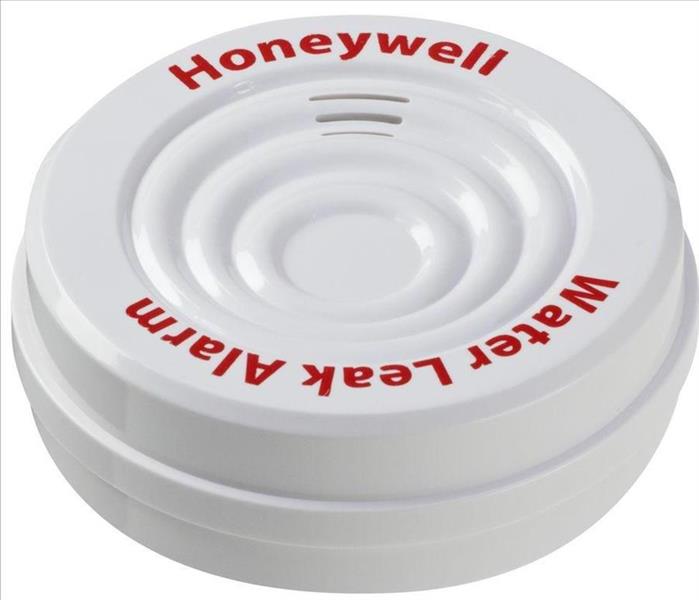 Water Leak Detector
Water Leak Detector
"I just woke up and found my house is flooded with water! At some point last night a pipe under my kitchen sink broke and now there's water everywhere. Please help me."
We get this phone call all of the time. It's more common than you think for a water pipe to accidentally break or for a hot water heater to explode, causing several gallons of water to leak in your home. Accidents do happen though. Pipes get old and break. Appliances often malfunction. So, how do you prevent waking up in the morning to wet, squishy bedroom floors? Water leak detectors work like smoke detectors in that they will sound an alarm to notify you of a water leak. You can purchase a water leak detector from a hardware store, like The Home Depot or Lowe's, or from an online retailer for about ten dollars. Simply leave the water leak detector in places prone to cause water damage like under sinks and in the drip pan under your hot water heater. If an accident were to occur, then upon hearing the alarm you should quickly act to find which alarm is sounding and turn off the water supply to that sink or turn off your hot water heater. This simple product can help to diminish a water damage disaster in your home, saving you time and money.
If a water damage event has already happened in your home, then follow these tips to prevent further damages.
SERVPRO of Greater Covington and Mandeville is available 24/7/365 for emergency water damage restoration.
SERVPRO of Greater Covington and Mandeville is an IICRC Certified Firm
8/9/2018 (Permalink)
SERVPRO of Greater Covington and Mandeville is an IICRC firm. The Institute of Inspection, Cleaning and Restoration Certification (IICRC) creates the standards for the restoration industry and provides training and certification to restoration companies. IICRC Certified Firms have the right to display the IICRC Certified Logo.
IICRC Certified Firms must
• Present accurate information to consumers and conduct business with honesty and integrity.
• Require a technician on all jobs who has been formally trained and passed all required tests.
• Require a continuing education program to keep technicians up-to-date on the latest changes in the industry.
• Maintain liability insurance to protect all parties in the event of an accident.
• Maintain a written complaint policy and agree to Better Business Bureau or similar arbitration to resolve disputes, and accept the conclusions and recommendations of arbitration.
The IICRC Develops The Standards For The Restoration Industry
The IICRC has been the driving force in establishing the main industry standards and reference guides for professional carpet cleaning, water damage restoration and mold remediation. These IICRC standards take years to develop and require the coordination of experts in the field: manufacturers, industry organizations, insurance professionals, training schools, contractors, and public health professionals.
Every five years, the standards are reviewed and updated. The water damage restoration field changes rapidly with advancements in technology and science, and therefore the standards must evolve to keep pace.
About SERVPRO of Greater Covington and Mandeville
SERVPRO of Greater Covington and Mandeville specializes in the cleanup and restoration of residential and commercial property after a fire, smoke or water damage event. Our staff is highly trained in property damage restoration and we are an IICRC Certified Firm. We believe in continuous training: from initial and ongoing training at SERVPRO’s corporate training facility to regular IICRC-industry certification, rest assured our staff is equipped with the knowledge to restore your property.
How to Prevent Further Damages After a Water Damage Event
8/8/2018 (Permalink)
Water damage is the second most common insurance claim filed in the United States. Unfortunately, accidents do happen and it's fairly common for appliances and water pipes to break and cause gallons of water to leak into your home. If you notice a water leak in your home, then please follow these tips to prevent further damages:
- Shut off the water source if possible or contact professional to do so
- Remove excess water by mopping and blotting
- Remove and prop up wet upholstery cushions for even drying
- Place aluminum foil or wood blocks under furniture legs to prevent discoloration
- Hang furs and leather goods separately at room temperature
- Remove Oriental or other colored rugs from wet carpeting to prevent staining
- Do not use a regular vacuum to remove water
- Do not turn on ceiling fixtures if ceiling is wet, and keep out of areas where ceilings are sagging from retained water
- Do not leave books, magazine or other colored items on wet carpeting.
- Call SERVPRO of Greater Covington and Mandeville at 985-871-5375. We have water damage restoration technicians available 24/7 for emergency services.
Water Damage Restoration in Amite
7/11/2018 (Permalink)
In July of 2018, a family in Amite returned home from vacation only to discover water leaking from their attic. Sometime while they were away their hot water heater malfunctioned. This caused hundreds of gallons of water to leak from the attic to both floors of their home. To be exact, a little over fourteen hundred square feet of the home was affected. Two hours after receiving notice of the situation, our team was at the home beginning the water damage restoration process. Out water damage restoration technicians extracted all of the water, removed the wet insulation and baseboards to ensure proper drying, and utilized our professional drying equipment. In as little as four days the job was completed and our customers were impressed.
Before you and your family leave for vacation please follow these tips to properly protect your home from a similar disaster.
Is your home safe when you're on vacation?
6/19/2018 (Permalink)
According to a study by AAA, thirty-five percent of Americans plan on taking at least one family vacation every year. If you plan on traveling for more than a couple of days, then you should make sure your home is properly protected while you’re away. Of course, you already know to check and double check that each window and door is properly locked, but you may be missing a couple of steps that will ensure your home is truly safe while you and your family are elsewhere.
Don’t let people know your home is empty.
- Suspend mail and newspaper services. You can sign up online to suspend USPS mail service and have your mail delivered to a local post office for up to thirty days. For trips longer than thirty days you should ask a neighbor or friend to pick up your mail. Contact your newspaper provider and ask them to temporarily postpone deliveries.
- Arrange for lawn care services while you’re gone. This will help make your home seem less abandoned to strangers.
- Install exterior lighting or motion detectors to deter burglars.
- Wait to post vacation pictures on social media. I know this is almost impossible for most people, but resist the urge to let the world know you’re not at home. Enjoy the time with your family or friends and post pictures when you return.
Accident-proof your home.
- Check the batteries in home security devices, including motion detectors, cameras, and smoke and carbon monoxide detectors. Replace them if necessary.
- Shut off the main water supply. Often times a homeowner will call us upon returning from vacation because they have learned a broken pipe or malfunctioning appliance has caused water damages. After you turn off the water main valve you then need to empty the pipes by running water in your sinks and flushing your toilets. If you would like to leave the water on for an automated sprinkler system, then at least turn off the water supply to the dishwasher, washing machine, and to each toilet. You may think this is an uncommon event, but trust me, this happens all too often. You don’t want to come home to a disaster. Save yourself time and money by being just a little overcautious.
- Conserve energy. Switch your water heater to vacation mode or turn it off completely. Most water heaters now have a pre-programmed vacation mode. If yours does not, then you should be able to manually adjust the temperature. Another way to conserve energy is to set your thermostat to either four degrees above or below your normal temperature. For summer months, set the thermostat in the upper 70’s. For winter months, set the thermostat in the upper 50’s.
- Prevent a power surge by unplugging your electronics or make sure they are plugged into a surge protector.
- If you often lose power during a storm or day of heavy rain, then before you leave for vacation freeze a cup of water, place a penny on top of it, and leave it in your freezer. When you return home check to see if the penny is frozen on top of the cup. If the penny is not frozen on top, then this means your house lost power sometime during your trip. Inspect the food inside your refrigerator and freezer. You may need to throw several items away.
I hope these tips help to protect your home and give you more peace of mind during your next vacation.
Sewage Backup Tips
1/15/2018 (Permalink)
The most common causes for a sewage system backup are clogs, tree roots, and broken or collapsed sewer lines. Clogs can be easily prevented with regular maintenance and proper use of your system. Do not flush anything besides toilet paper in your toilet. Do not overuse your garbage disposal. Also, do not pour grease down the drain. Grease and fat will harden in your pipes and create a backup issue. Tree roots can compromise and break sewer pipes by growing into the pipes or wrapping around them. Unfortunately, you may not be able to prevent this issue so easily. Sometimes tree roots from a neighbors property can grow around your sewer pipes. Also, sometimes sewer pipes break simply because of time. Older systems were built using cast iron and clay piping which slowly weaken over time. If you have an older home this may present an issue for you in the future. To prevent your sewer system from backing up, we suggest you have a professional plumber check on the current condition of your sewer system and address any issues they find. Regular home maintenance is the key to preventing water damages to your home.
Please note raw sewage contains harmful bacteria, parasites, fungi, and viruses. It is extremely dangerous for those with compromised or weak immune systems. Only the most trained professionals should attempt sewage remediation work.
If your sewer system has backed up and caused raw sewage to flow into your home or business, please give us a call today at 985-871-5375.
Tips for Filing a Water Damage Claim with Your Insurance Company
11/13/2017 (Permalink)
Water damage is the second most frequently filed insurance claim in the United States. According to the Insurance Information Institute, about one in every fifty homes has a property damage claim caused by water damage or freezing temperatures each year. The most common causes for water damage are broken pipes, faulty plumbing, and buildup in areas prone to collecting water (crawl spaces, attics, basements, etc.), defective household appliances, and malfunctioning HVAC systems. If something has caused water damage in your home, then you must begin to mitigate the damage immediately to prevent any future damages.
Follow these helpful tips when dealing with a water damage claim:
- You must stop the source of the damage immediately. If water is still flowing, then shut off the water supply to your house.
- Document everything. Take photos of the damage. Keep records of every phone call with your insurance company, including date, time, and other details.
- Save receipts. If you start any repairs yourself, then save the receipts for tools or equipment you purchase. If you need to stay in a hotel, then save receipts for the hotel and any living expenses you acquired because you were temporarily displaced.
- Do not make any permanent repairs yourself until the insurance adjuster has visited your home and assessed the damages.
- Do not throw anything away until the adjuster or insurance company has instructed you to do so.
SERVPRO of Greater Covington and Mandeville specializes in water damage restoration. We are available 24/7 every day of the year.
985-871-5375
SERVPRO of Greater Covington and Mandeville's Satisfied Customers
8/15/2017 (Permalink)
SERVPRO of Greater Covington and Mandeville proudly serves our community. We specialize in water damage restoration, fire damage restoration, and mold remediation. We understand how difficult and emotional it can be to deal with a disaster. Our crew works hard to provide relief for our customers and assure them we can make it "Like it never even happened."
Here are a few customer testimonials of our water damage restoration services:
"I contacted Coty and asked him to be on standby while I called corporate for directions. We had an emergency situation. Coty had a crew working within two hours. I found it exceptional that they were here as quickly as possible and began working immediately." - Lisa
"We are very pleased with the professionalism and the services provided, but I think what impressed us the most was the respect we were given by the two gentlemen who worked with us. Thank you for the exceptional work and for exceeding our expectations. I hope that God gives us other, if less messy, opportunities to work together again in the future." - a local Covington business
"Wonderful experience working with you guys. Thank you for everything!!" - Marc
We love helping our community and are always thrilled to hear great customer feedback!
We're Here to Help
8/9/2017 (Permalink)
Flooding and water emergencies don’t wait for regular business hours and neither do we. SERVPRO of Greater Covington and Mandeville provides emergency cleaning and restoration services 24 hours a day, 7 days a week—including all holidays.
Faster To Any Size Disaster
Flooding and water damage is very invasive. Water quickly spreads throughout your home and gets absorbed into floors, walls, furniture, and more. SERVPRO of Greater Covington and Mandeville arrives quickly and starts the water extraction process almost immediately. This immediate response helps to minimize the damage and the cleaning and restoration costs.
Need Emergency Service? Call Us 24/7 – 985-871-5375
Water Damage Timeline
Within Minutes
- Water quickly spreads throughout your property, saturating everything in its path.
- Water is absorbed into walls, floors, upholstery, and belongings.
- Furniture finishes may bleed, causing permanent staining on carpets.
- Photographs, books, and other paper goods start to swell and warp.
Hours 1 - 24:
- Drywall begins to swell and break down.
- Metal surfaces begin to tarnish.
- Furniture begins to swell and crack.
- Dyes and inks from cloth and paper goods spread and stain.
- A musty odor appears.
48 Hours to 1 Week:
- Mold and mildew may grow and spread.
- Doors, windows, and studs swell and warp.
- Metal begins to rust and corrode.
- Furniture warps and shows signs of mold.
- Paint begins to blister.
- Wood flooring swells and warps.
- Serious biohazard contamination is possible.
More Than 1 Week:
- Restoration time and cost increase dramatically; replacing contaminated materials and structural rebuilding may be extensive.
- Structural safety, mold growth, and biohazard contaminants pose serious risks to occupants.
About SERVPRO of Greater Covington and Mandeville
SERVPRO of Greater Covington and Mandeville specializes in the cleanup and restoration of residential and commercial property after a fire, smoke or water damage event. Our staff is highly trained in property damage restoration. From initial and ongoing training at SERVPRO’s corporate training facility to regular IICRC-industry certification, rest assured our staff is equipped with the knowledge to restore your property.
Click here to meet our crew
Click here to learn more about our work around town
Water Damage Restoration Process
7/17/2017 (Permalink)
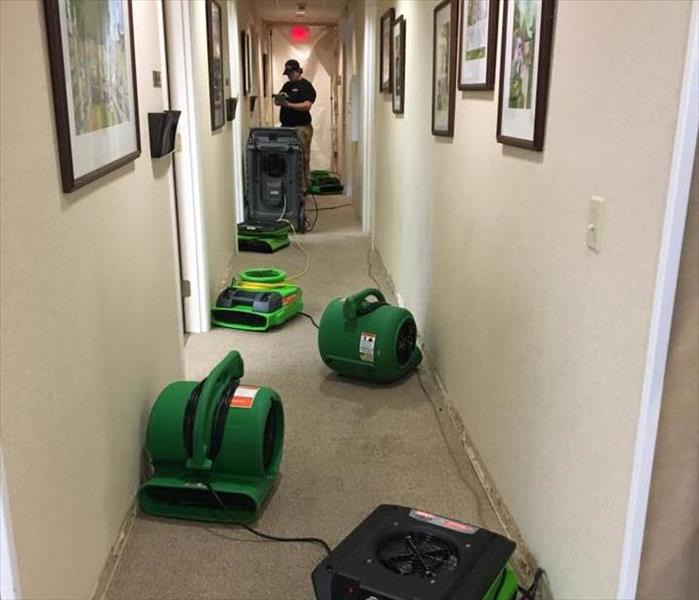 Photographed is one of our technicians, Jared, monitoring the drying process at a local law office.
Photographed is one of our technicians, Jared, monitoring the drying process at a local law office.
SERVPRO of Greater Covington and Mandeville specializes in water damage restoration for both residential and commercial properties.
Steps of the Water Damage Restoration Process:
1- Identify Source
We will check for the source of water. The source must be stopped before any drying or restoration work can begin.
2- Identify Type of Water
We will identify the category and classification of water damage to ensure we restore the property based on industry guidelines.
3- Survey Extent of Damage
We inspect and test the damaged area to determine the extent of damage and how far the moisture has traveled to ensure proper and complete restoration.
4- Move Furniture and Contents
We move furniture and contents to prevent further damage to flooring and contents.
5- Dispose of Unsalvageable Items
With guidance from property owner and adjuster, we will help determine which items can or can not be restored.
6- Extract Water
We extract excess water from affected areas.
7- Deodorize and Disinfect
Our process may require deodorizers as odor treatments or EPA-registered disinfectants as antimicrobial treatments.
8- Utilize Drying Equipment
We utilize our drying equipment to remove moisture and bring the relative humidity back to normal.
9- Monitor Drying Process Until Complete
Once drying equipment is in place, we will periodically check the moisture level readings until the affected areas are completely dry.
Emergency Water Damage Tips
7/17/2017 (Permalink)
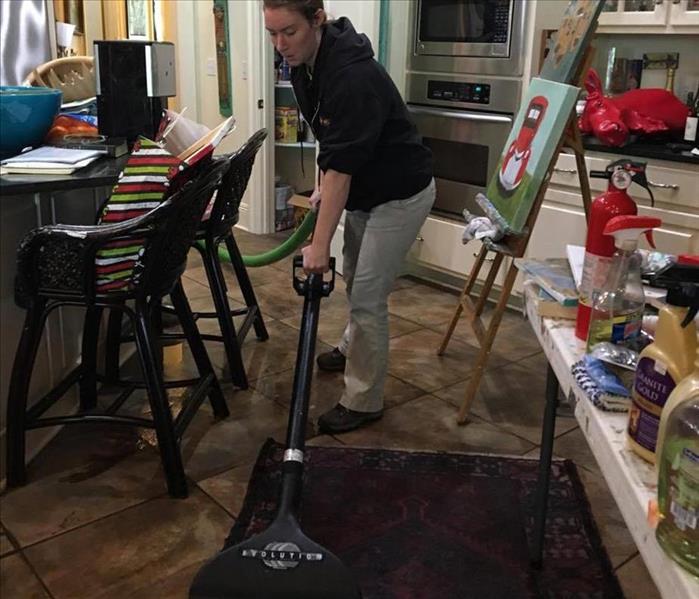 Pictured here is one of our technicians, Anne, extracting water from a home in Abita Springs.
Pictured here is one of our technicians, Anne, extracting water from a home in Abita Springs.
When your home or business has incurred water damage you can help mitigate your losses by following these tips:
- Shut off the water source if possible or contact professional to do so
- Remove excess water by mopping and blotting
- Remove and prop up wet upholstery cushions for even drying
- Place aluminum foil or wood blocks under furniture legs
- Hang furs and leather goods separately at room temperature
- Remove Oriental or other colored rugs from wet carpeting to prevent staining
- Do not use a regular vacuum to remove water
- Do not turn on ceiling fixtures if ceiling is wet, and keep out of areas where ceilings are sagging from retained water
- Do not leave books, magazine or other colored items on wet carpeting.
- Call SERVPRO of Greater Covington and Mandeville at 985-871-5375






 24/7 Emergency Service
24/7 Emergency Service














